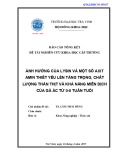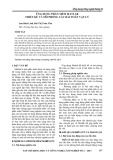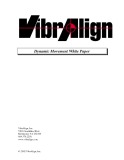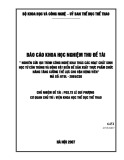
RESEARC H Open Access
Bioelectrical impedance analysis in clinical
practice: implications for hepatitis C therapy BIA
and hepatitis C
Alisan Kahraman
1
, Johannes Hilsenbeck
1,2
, Monika Nyga
1
, Judith Ertle
1
, Alexander Wree
1
, Mathias Plauth
3
,
Guido Gerken
1
, Ali E Canbay
1*
Abstract
Background: Body composition analysis using phase angle (PA), determined by bioelectrical impedance analysis
(BIA), reflects tissue electrical properties and has prognostic value in liver cirrhosis. Objective of this prospective
study was to investigate clinical use and prognostic value of BIA-derived phase angle and alterations in body
composition for hepatitis C infection (HCV) following antiviral therapy.
Methods: 37 consecutive patients with HCV infection were enrolled, BIA was performed, and PA was calculated
from each pair of measurements. 22 HCV genotype 3 patients treated for 24 weeks and 15 genotype 1 patients
treated for 48 weeks, were examined before and after antiviral treatment and compared to 10 untreated HCV
patients at 0, 24, and 48 weeks. Basic laboratory data were correlated to body composition alterations.
Results: Significant reduction in body fat (BF: 24.2 ± 6.7 kg vs. 19.9 ± 6.6 kg, genotype1; 15.4 ± 10.9 kg vs. 13.2 ±
12.1 kg, genotype 3) and body cell mass (BCM: 27.3 ± 6.8 kg vs. 24.3 ± 7.2 kg, genotype1; 27.7 ± 8.8 kg vs. 24.6 ±
7.6 kg, genotype 3) was found following treatment. PA in genotype 3 patients was significantly lowered after
antiviral treatment compared to initial measurements (5.9 ± 0.7° vs. 5.4 ± 0.8°). Total body water (TBW) was
significantly decreased in treated patients with genotype 1 (41.4 ± 7.9 l vs. 40.8 ± 9.5 l). PA reduction was
accompanied by flu-like syndromes, whereas TBW decline was more frequently associated with fatigue and
cephalgia.
Discussion: BIA offers a sophisticated analysis of body composition including BF, BCM, and TBW for HCV patients
following antiviral regimens. PA reduction was associated with increased adverse effects of the antiviral therapy
allowing a more dynamic therapy application.
Background
Bioelectrical impedance analysis (BIA) has been intro-
duced as a non-invasive, rapid, easy to perform, repro-
ducible, and safe technique for the analysis of body
composition [1]. It is based on the assumption that an
electric current is conducted well by water and electro-
lyte-containing parts of a body but poorly by fat and
bone mass. A fixed, low-voltage, high-frequency alter-
nating current introduced into the human body or tissue
is conducted almost completely through the fluid
compartment of the fat-free mass [2]. BIA measures
parameters such as resistance (R) and capacitance (Xc)
by recording a voltage drop in applied current [3]. Capa-
citance causes the current to lag behind the voltage,
which creates a phase shift. This shift is quantified geo-
metrically as the angular transformation of the ratio of
capacitance to resistance, or the phase angle (PA) [4].
PA reflects the relative contribution of fluid (resistance)
and cellular membranes (capacitance) of the human
body. By definition, PA is positively associated with
capacitance and negatively associated with resistance [4].
PA can also be interpreted as an indicator of water dis-
tribution between the extra- and intracellular space, one
of the most sensitive indicators of malnutrition [5,6].
* Correspondence: ali.canbay@uni-due.de
1
University Clinic Duisburg-Essen, Department of Gastroenterolgy and
Hepatology, Hufelandstrasse 55, 45122 Essen, Germany
Full list of author information is available at the end of the article
Kahraman et al.Virology Journal 2010, 7:191
http://www.virologyj.com/content/7/1/191
© 2010 Kahraman et al; licensee BioMed Central Ltd. This is an Open Access article distributed under the terms of the Creative
Commons Attribution License (http://creativecommons.org/licenses/by/2.0), which permits unrestricted use, distribution, and
reproduction in any medium, provided the original work is properly cited.






























